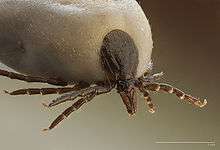Tick-borne encephalitis
| Tick-borne meningoencephalitis | |
|---|---|
 Infected countries/areas in Eurasia | |
| Classification and external resources | |
| Specialty | Infectious disease |
| ICD-10 | A84 |
| ICD-9-CM | 063 |
| DiseasesDB | 29274 |
| Patient UK | Tick-borne encephalitis |
| MeSH | D004675 |
Tick-borne encephalitis (TBE) is a viral infectious disease involving the central nervous system. The disease most often manifests as meningitis, encephalitis, or meningoencephalitis. Although TBE is most commonly recognized as a neurological disorder, mild fever can also occur. Long-lasting or permanent neuropsychiatric sequelae are observed in 10 to 20% of infected patients.
The number of reported cases has been increasing in most countries.[1]
The tick-borne encephalitis virus is known to infect a range of hosts including ruminants, birds, rodents, carnivores, horses and humans. The disease can also be zoonotic, with ruminants and dogs providing the principal source of infection for humans.[2]
TBE, like Lyme disease, is one of the many tick-borne diseases.
Signs and symptoms

The virus can infect the brain (encephalitis), the meninges (meningitis) or both (meningoencephalitis).[3] In general, mortality is 1% to 2%, with deaths occurring 5 to 7 days after the onset of neurologic signs.
In dogs, the disease also manifests as a neurological disorder with signs varying from tremors to seizures and death.[2]
In ruminants, neurological disease is also present, and animals may refuse to eat, appear lethargic, and also develop respiratory signs.[2]
Cause
TBE is caused by tick-borne encephalitis virus, a member of the genus Flavivirus in the family Flaviviridae. It was first isolated in 1937. Three virus sub-types are described: European or Western tick-borne encephalitis virus, Siberian tick-borne encephalitis virus, and Far-Eastern tick-borne encephalitis virus (formerly known as Russian spring summer encephalitis virus).
Russia and Europe report about 5,000-7,000 human cases annually.[1][4]
The former Soviet Union conducted research on tick borne diseases, including the TBE viruses.
Transmission

It is transmitted by the bite of several species of infected ticks, including Ixodes scapularis, I. ricinus and I. persulcatus,[5] or (rarely) through the non-pasteurized milk of infected cows.[6]
Diagnosis
The TBE virus may be present in a seronegative strain or subtype. In such cases a marker for TBE infection is elevated IFN-g in CSF.
Viral antigen can usually be found in brain tissue. Serological testing can also be performed with an ELISA.[2]
Treatment and prevention
The disease is incurable once manifested, so there is no specific drug therapy for TBE. Symptomatic brain damage requires hospitalization and supportive care based on syndrome severity. Anti-inflammatory drugs, such as corticosteroids, may be considered under specific circumstances for symptomatic relief. Tracheal intubation and respiratory support may be necessary.
Prevention includes non-specific (tick-bite prevention, tick checks) and specific prophylaxis in the form of a vaccine. TBE immunoglobulin is no longer used. Tick-borne encephalitis vaccine is very effective and available in many disease endemic areas and in travel clinics.[7]
Epidemiology
The disease is most common in Central and Eastern Europe, and Northern Asia. About ten to twelve thousand cases are documented a year.[8]
References
- 1 2 Suss J (June 2008). "Tick-borne encephalitis in Europe and beyond--the epidemiological situation as of 2007". Euro Surveill. 13 (26). PMID 18761916.
- 1 2 3 4 Tickborne Encephalitis Virus reviewed and published by WikiVet, accessed 12 October 2011.
- ↑ Kaiser R (September 2008). "Tick-borne encephalitis". Infect. Dis. Clin. North Am. 22 (3): 561–75, x. doi:10.1016/j.idc.2008.03.013. PMID 18755391.
- ↑ Salisbury, Dr David; Noakes, Dr Karen (2006). Immunisation against infectious disease (Third ed.). TSO (The Stationery Office - UK Department Of Health). pp. 385–390. ISBN 978-0-11-322528-6
- ↑ Dumpis U, Crook D, Oksi J (April 1999). "Tick-borne encephalitis". Clin. Infect. Dis. 28 (4): 882–90. doi:10.1086/515195. PMID 10825054.
- ↑ CDC Yellow Book, accessed 5 October 2013.
- ↑ Demicheli V, Debalini MG, Rivetti A (2009). Demicheli, Vittorio, ed. "Vaccines for preventing tick-borne encephalitis". Cochrane Database Syst Rev (1): CD000977. doi:10.1002/14651858.CD000977.pub2. PMID 19160184.
- ↑ "Vaccines against tick-borne encephalitis: WHO position paper." (PDF). Releve epidemiologique hebdomadaire / Section d'hygiene du Secretariat de la Societe des Nations = Weekly epidemiological record / Health Section of the Secretariat of the League of Nations 86 (24): 241–56. 10 June 2011. PMID 21661276.
External links
| ||||||||||||||||||||||||||||||||||||||||||||||||||||||||||||||||||||||||||||||||||||||||||||||||
| ||||||||||||||||||||||||||||||||||||||||||
|